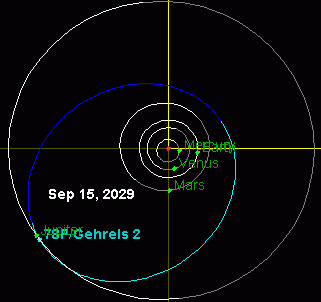78P/Gehrels
| Discovery | |
|---|---|
| Discovered by | Tom Gehrels |
| Discovery date | September 29, 1973 |
| Designations | |
| 1973 XI; 1981 XVII; 1989 XVII | |
| Orbital characteristics | |
| Epoch | March 6, 2006 |
| Aphelion | 5.462 AU |
| Perihelion | 2.009 AU |
| Semi-major axis | 3.735 AU |
| Eccentricity | 0.4622 |
| Orbital period | 7.22 yr |
| Inclination | 6.2530° |
| Last perihelion | January 12, 2012[1] October 27, 2004[2][3] |
| Next perihelion | 2019 April 2[4] |
78P/Gehrels, also known as Gehrels 2, is a Jupiter-family periodic comet in the Solar System with a current orbital period of 7.22 years.
It was discovered by Tom Gehrels at the Lunar and Planetary Laboratory, Arizona, USA on photographic plates exposed between 29 September and 5 October 1973 at the Palomar Observatory. It had a brightess of apparent magnitude of 15. Brian G. Marsden computed the parabolic and elliptical orbits which suggested an orbital period of 8.76 years, later revising the data to give a perihelion date of 30 November 1963 and orbital period of 7.93 years.[5]
The comet's predicted next appearance in 1981 was observed by W. and A. Cochran at the McDonald Observatory, Texas on 8 June 1981. It was observed again in 1989 and in 1997, when favourable conditions meant that brightness increased to magnitude 12. It has subsequently been observed in 2004 and 2012.
Outward migration
Comet 78P/Gehrels' aphelion (furthest distance from the Sun) of 5.4AU[1] is in the zone of control of the giant planet Jupiter and the orbit of the comet is frequently perturbed by Jupiter.[6] On September 15, 2029, the comet will pass within 0.018 AU (2.7 million kilometers) of Jupiter[6] and be strongly perturbed. By the year 2200, the comet will have a centaur-like orbit with a perihelion (closest distance to the Sun) near Jupiter.[7] This outward migration from a perihelion of 2AU to a perihelion of ~5AU could cause the comet to go dormant.
| AU | 2009[1] | 2030 | 2200[7] |
|---|---|---|---|
| Semi-major axis | 3.73 | 6.02 | 9.37 |
| Perihelion | 2.00 | 4.08 | 4.99 |
| Aphelion | 5.46 | 7.96 | 13.7 |

See also
References
- ^ a b c "JPL Small-Body Database Browser: 78P/Gehrels 2" (2011-05-21 last obs). Retrieved 2009-05-11.
- ^ Seiichi Yoshida (2006-10-03). "78P/Gehrels 2". Seiichi Yoshida's Comet Catalog. Retrieved 2010-02-24.
- ^ Syuichi Nakano (2009-04-20). "78P/Gehrels 2 (NK 1760)". OAA Computing and Minor Planet Sections. Retrieved 2010-02-24.
- ^ Syuichi Nakano (2011-06-10). "78P/Gehrels 2 (NK 2102)". OAA Computing and Minor Planet Sections. Retrieved 2012-02-18.
- ^ "78P/Gehrels 2". Cometography. Retrieved 25 February 2015.
- ^ a b c "JPL Close-Approach Data: 78P/Gehrels 2" (2006-02-26 last obs). Retrieved 2009-05-11.
- ^ a b Heider. "Orbital Elements of 78P/Gehrels in 2200". Retrieved 2009-05-11.
External links
- Orbital simulation from JPL (Java) / Horizons Ephemeris
- 78P/Gehrels 2 (2012)
- 78P at Kronk's Cometography
- Lightcurve (Artyom Novichonok)
- 78P as seen by 10" GRAS-04 on 2011-05-03 (120 sec x 6)
- 78P as seen by 0.3-metre (12 in) Schmidt-Cassegrain on 2011 08 06 (3 x 748 sec) and 2011 08 09 (6 x 600 sec)


